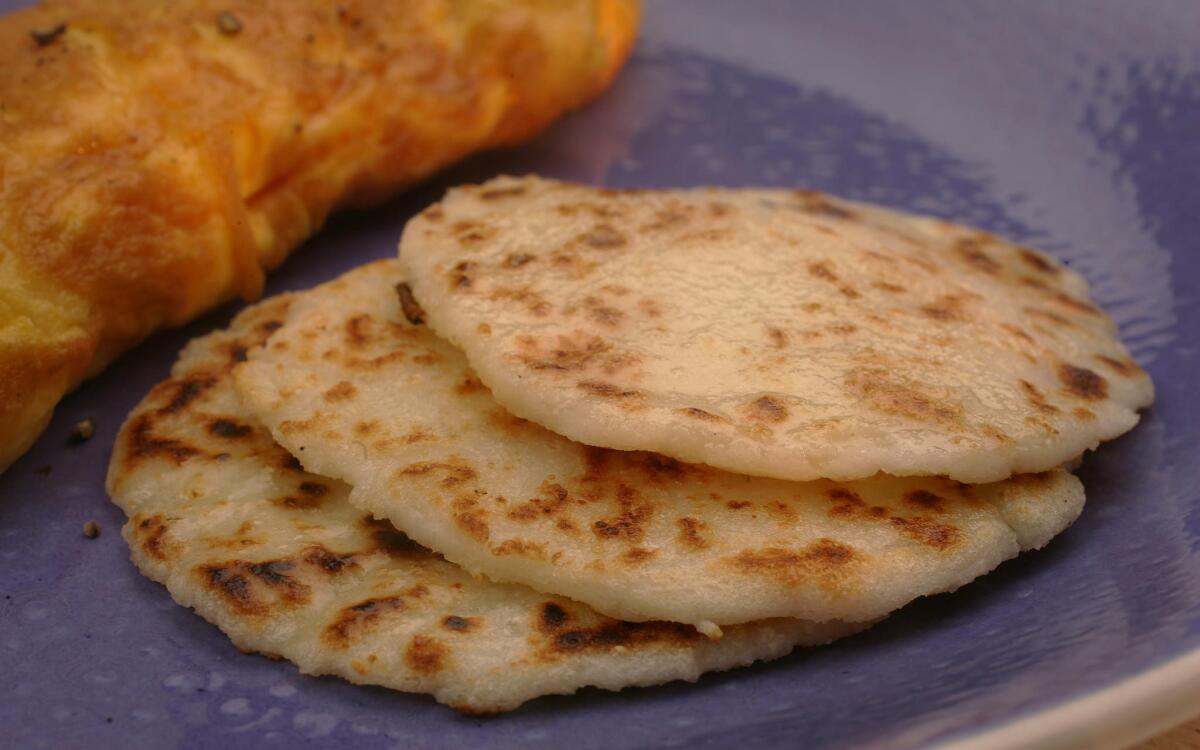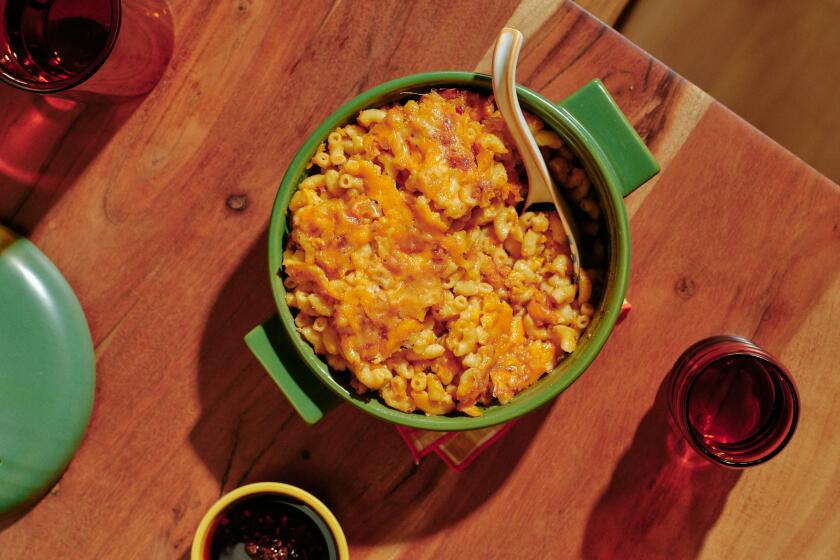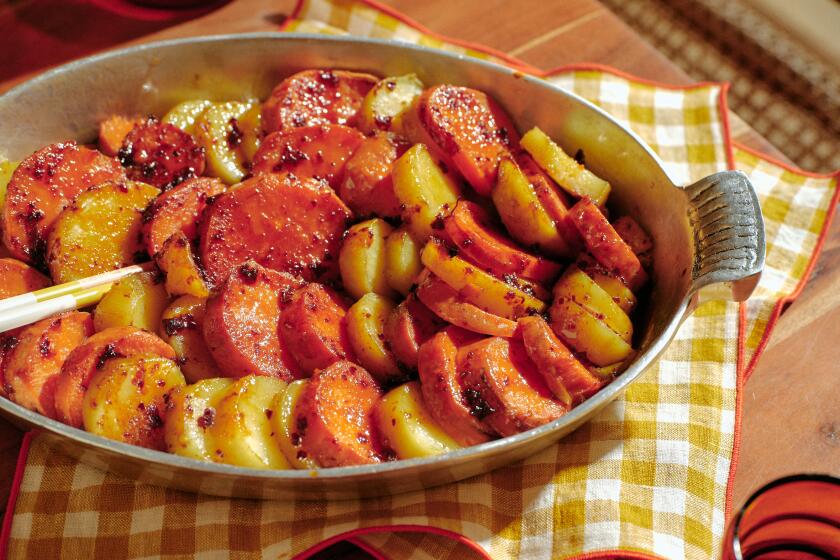Cheese arepas

Griddle cakes are elemental. Like porridge and roasted meat, they’re ancient preparations, seemingly slapped together at the fireside for as long as humans have gathered around that fire to eat. But in cooking, elemental never means unchanging. Corn griddle cakes, for example, simple folk food in dozens of cultures, come in many guises. Venezuelan or Columbia arepas. Oaxacan clayudas. Indonesian bregedel jagung. All-American cornmeal pancakes.
They may be basic, but they can have amazing flavor and texture, whatever the country of origin.
At Posh on Pico, a cafe with Latino-inspired food, chef-owner Maricarmen Rodriguez’s omelets and breakfast dishes come with arepas rather than hash browns or toast. Made with finely ground, precooked white corn flour, arepas are a mainstay in Colombia, where they are thin, and in Venezuela, where they’re thick and often stuffed with meat or vegetables. Like tortillas, they’re a bread-like staple, once made of corn pounded in a mortar and pestle and cooked on an earthenware griddle. In South America, arepas are often topped with or wrapped around slices of melting cheese, but some are stuffed with grated mild white cheese. Rodriguez, who is from Honduras, adds queso fresco, mozzarella or feta cheese to the batter, which is kneaded as it’s mixed.
The best way to eat arepas is straight off the griddle. They’re finger food, like toast, meant to be spread with butter or jam, or used as a scoop to eat other foods on the plate. Rodriguez’s arepas are thin, with a creamy flavor reminiscent of grits. But comparisons don’t apply. They may be patted out like tortillas, cooked on a griddle like pancakes and bring to mind your favorite cheese-grits recipe, but arepas have their own unique flavor and texture.
Fresh corn kernels are the basis for bregedel jagung, savory Indonesian corn cakes with shrimp and green onions. Corn was introduced to certain parts of Indonesia by the Spanish in the 17th century, notably to an island off Java called Madura.
Finely chopped shrimp, onions, celery, garlic and cilantro are mixed with eggs, corn and a little cream. The sweetness of the corn and cream is balanced by the distinctive brininess of the shrimp and the crunch of the herbs and vegetables.
These corn cakes make a terrific appetizer, two or three to a serving, or offered on a platter at a buffet. Although arepas and cornmeal pancakes are best straight off the griddle, they can be kept at room temperature, the way much food is eaten in Indonesia. That makes them perfect party food.
For the cakes that call for corn kernels, remember that Mexican corn is available in our markets year-round. Though it’s too tough in the winter to be great for eating on the cob, it works admirably in these dishes.
When making corn cakes, use a griddle, or a well-seasoned cast iron skillet -- or whatever you’d use to make pancakes. Rodriguez’s trick of flattening arepa dough between plastic sheets made from plastic bags (sturdier than regular plastic wrap) works well, or you can keep a bowl of water handy and moisten your fingers from time to time to keep the dough from sticking as you work. The malt-enriched corn pancakes from Doughboys cafe on West 3rd Street cook like regular pancakes, but quickly; they need just a minute or two per side. Bregedel jagung are like fritters and have good body. They’re easily managed as you cook and don’t spread too much but retain a nice shape.
However you slap ‘em together, remember that you’re in good company -- the ghosts of a long line of griddle-cake makers are surely hovering around you as you work, waiting for one more delectable bite.
Combine the arepa masa, cheese and salt in a bowl.
Combine the water, milk and butter in a saucepan and bring to a boil. Remove from heat and cool until just warm enough to touch.
Add a little of the warm milk mixture to the masa mixture and knead to mix. Add a little more liquid and knead again, continuing until you have incorporated all the liquid and the mixtures have combined to make a dough.
To make the arepas, take a scant one-fourth cup dough, form into a ball and pat out between the palms of your hands like a tortilla, and to about the same thickness. Or cut a resealable plastic bag in half to make 2 plastic sheets. Place a ball of dough on one plastic sheet, cover with the other sheet and press flat with a rolling pin or a round object such as a flat-bottomed can. The arepas should be about 3 inches in diameter. Place them on a baking sheet and cover with a damp cloth until ready to cook.
Heat an ungreased seasoned griddle or nonstick skillet and cook the arepas 2 to 3 minutes on each side until lightly golden brown. Serve immediately, with butter if desired.
Get our Cooking newsletter.
Your roundup of inspiring recipes and kitchen tricks.
You may occasionally receive promotional content from the Los Angeles Times.















